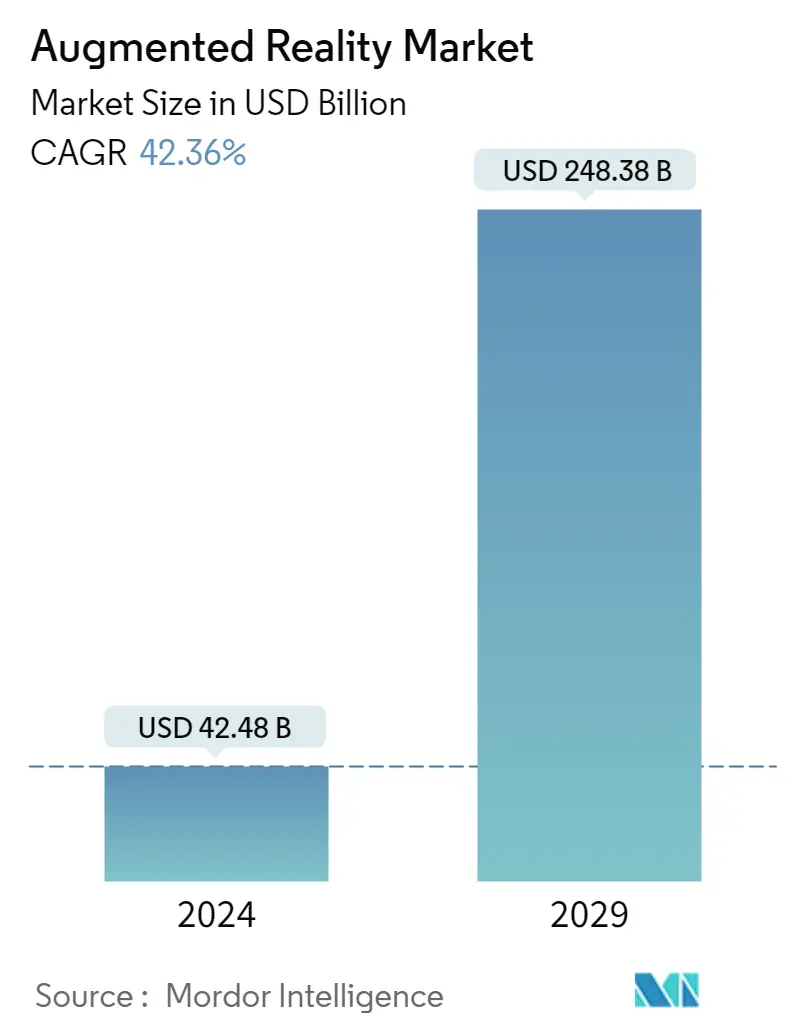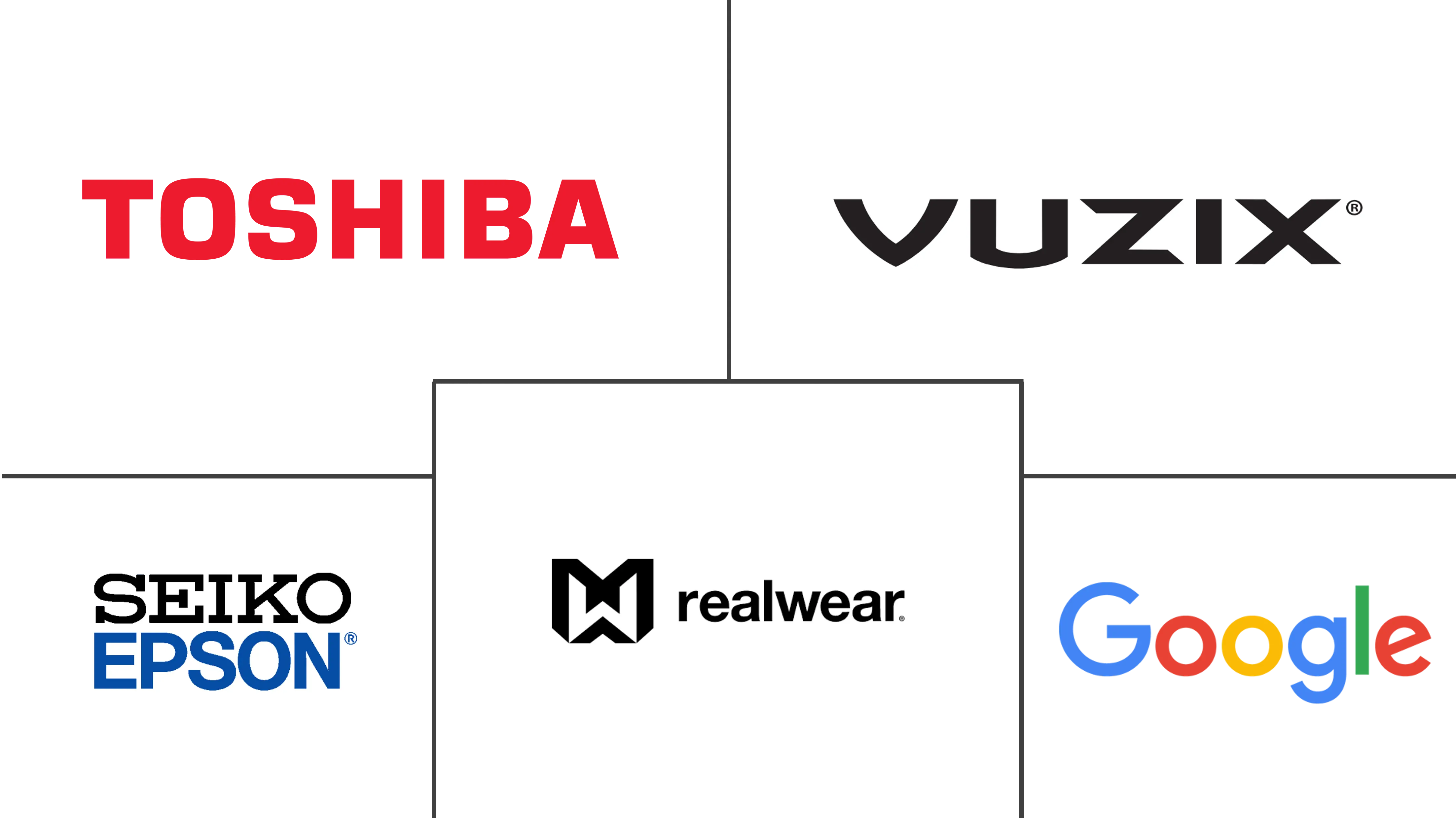Market Size of Augmented Reality Industry

| Study Period | 2019 - 2029 |
| Market Size (2024) | USD 42.48 Billion |
| Market Size (2029) | USD 248.38 Billion |
| CAGR (2024 - 2029) | 42.36 % |
| Fastest Growing Market | Asia Pacific |
| Largest Market | North America |
Major Players
*Disclaimer: Major Players sorted in no particular order |
Augmented Reality (AR) Market Analysis
The Augmented Reality Market size is estimated at USD 42.48 billion in 2024, and is expected to reach USD 248.38 billion by 2029, growing at a CAGR of 42.36% during the forecast period (2024-2029).
Augmented reality will likely present a new way to engage and expand retailers' abilities. The possibilities of augmented reality are endless, especially when combined with the ever-evolving wireless technology, which enables the integration of mobile devices and home appliances to provide an enhanced connected experience for the end-users. Tremendous potential opportunities in biotechnology and healthcare are expected to drive the growth of the augmented reality market over the forecast period.
- While AR is still over a decade away from achieving its full market potential, technological advancements in the space industry have accelerated the market studied over the past two years. The increasing availability of content and the launch of developer tools, such as ARKit, drive this segment's growth. Also, the growing adoption and availability of the cloud have been significant drivers for the AR market. It provides the platform and infrastructure to address the scalability limitation of on-premise AR experiences.
- During the forecast period, around 800 million smartphones are expected to be equipped with AR-supported hardware, processing units, graphics processing units (GPUs), digital signal processors (DSPs), and neural chips to power them. Dedicated AR support within a standard OS with lower costs of developing AR apps is expected to augment the market studied in the near future.
- The automobile industry is also moving toward the augmented reality business. Many automobile companies are using artificial intelligence technologies and augmented reality (through head-up displays) to mark their presence in the market. Manufacturers, including BMW, Mercedes-Bez, Chevrolet, Toyota, and Volvo, have already included augmented reality features. Furthermore, new auto manufacturers are investing in this space to explore new applications.
- The potential of augmented reality technology to transform interior navigation; for instance, the software development company MobiDev has changed interior navigation using AR technology. With the aid of the company's ARcore technology, the best path to the desired location can be suggested and displayed on a mobile device. Regarding outdoor navigation, augmented reality (AR) technology can assist tourists in finding tourist attractions and suitable lodging via AR-based virtual tours. For instance, Hub Hotels by Premier Inn uses augmented reality technology to turn its rooms into city maps that direct visitors to the area's top attractions. As a result, it is anticipated that existing players in the travel and tourism sector will want more AR-based solutions as AR technology in navigation increases.
- Additionally, amidst the COVID-19 crisis, physical lockdowns across significant regions may positively affect the AR/VR hardware demand. Enterprises worldwide are trying to find ways to get their internal and wider geographically spread teams to communicate, collaborate, and find a path forward during the crisis. This crisis can act as an accelerator to the existing trends for enterprise AR/VR adoption.
Augmented Reality (AR) Industry Segmentation
Objects in the actual world are enhanced by computer-generated image characteristics in augmented reality (AR), which can sometimes span many senses like aural, visual, somatosensory, haptic, and olfactory. A system that reliably registers virtual and real items in 3D merges the real and virtual worlds and enables real-time interaction is known as augmented reality (AR).
The augmented reality market is segmented by type (hardware and software), end-user vertical (gaming, education, healthcare, retail and advertising, automotive, and military and defense), and geography.
The market sizes and forecasts are provided in terms of value (USD billion) for all the above segments.
| By Type | |||||
| |||||
| Software |
| By End User | |
| Gaming | |
| Education | |
| Healthcare | |
| Retail and Marketing | |
| Automotive | |
| Military and Defense | |
| Other End-user Verticals |
| Geography | |||||||
| |||||||
| |||||||
| |||||||
| Rest of the World |
Augmented Reality Market Size Summary
The augmented reality (AR) market is poised for significant growth, driven by advancements in technology and increasing applications across various industries. The integration of AR with wireless technology is enhancing consumer engagement and expanding retail capabilities. The healthcare and biotechnology sectors are expected to be major contributors to market expansion, leveraging AR for innovative solutions. The automotive industry is also embracing AR, with companies like BMW and Mercedes-Benz incorporating AR features into their vehicles. The market is further bolstered by the growing availability of AR-supported hardware in smartphones and other devices, which is expected to enhance user experiences and drive adoption.
North America is anticipated to be a key region for AR market growth, supported by a strong presence of technology vendors and high adoption rates of smart devices. The United States, in particular, is a hub for AR innovation, with significant investments in market development. The region's industrialization and focus on safety are also contributing to market expansion. The retail and automotive sectors are increasingly adopting AR technologies, providing further opportunities for market growth. Companies are actively expanding their market presence through partnerships and collaborations, aiming to leverage AR for enhanced consumer experiences and operational efficiencies.
Augmented Reality Market Size - Table of Contents
-
1. MARKET INSIGHTS
-
1.1 Market Overview
-
1.2 Industry Stakeholder Analysis
-
1.3 Industry Attractiveness - Porter's Five Forces Analysis
-
1.3.1 Bargaining Power of Suppliers
-
1.3.2 Bargaining Power of Consumers
-
1.3.3 Threat of New Entrants
-
1.3.4 Threat of Substitute Products
-
1.3.5 Intensity of Competitive Rivalry
-
-
-
2. MARKET SEGMENTATION
-
2.1 By Type
-
2.1.1 Hardware
-
2.1.1.1 Standalone
-
2.1.1.2 Tethered
-
2.1.1.3 Screenless Viewer
-
-
2.1.2 Software
-
-
2.2 By End User
-
2.2.1 Gaming
-
2.2.2 Education
-
2.2.3 Healthcare
-
2.2.4 Retail and Marketing
-
2.2.5 Automotive
-
2.2.6 Military and Defense
-
2.2.7 Other End-user Verticals
-
-
2.3 Geography
-
2.3.1 North America
-
2.3.1.1 US
-
2.3.1.2 Canada
-
-
2.3.2 Europe
-
2.3.2.1 Germany
-
2.3.2.2 UK
-
2.3.2.3 France
-
2.3.2.4 Italy
-
2.3.2.5 Rest of Europe
-
-
2.3.3 Asia Pacific
-
2.3.3.1 India
-
2.3.3.2 China
-
2.3.3.3 Japan
-
2.3.3.4 Rest of Asia-Pacific
-
-
2.3.4 Rest of the World
-
-
Augmented Reality Market Size FAQs
How big is the Augmented Reality Market?
The Augmented Reality Market size is expected to reach USD 42.48 billion in 2024 and grow at a CAGR of 42.36% to reach USD 248.38 billion by 2029.
What is the current Augmented Reality Market size?
In 2024, the Augmented Reality Market size is expected to reach USD 42.48 billion.

